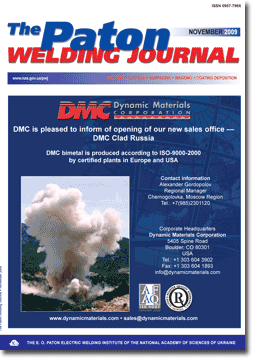| 2009 №11 (03) | 2009 №11 (05) |

TPWJ, 2009, #11, 18-22 pages
FEATURES OF EXPLOSION WELDING OF TITANIUM TO STEEL IN A SHIELDING ATMOSPHERE
Journal The Paton Welding Journal
Publisher International Association «Welding»
ISSN 0957-798X (print)
Issue № 11, 2009 (November)
Pages 18-22
Authors
O.L. PERVUKHINA1, L.B. Pervukhin1, A.A. BERDYCHENKO2, L.D. DOBRUSHIN3, V.G. PETUSHKOV3 and Yu.I. FADEENKO3
1Institute of Structural Macrokinetics and Problems of Materials Sciences, RAS, Chernogolovka, RF
2Altai State Technical University, Barnaul, RF
3E.O. Paton Electric Welding Institute, NASU, Kiev, Ukraine
Abstract
As proved by investigations, to produce a sound joint between steel and titanium on large-sized blanks by explosion welding, it is necessary to perform this process in a shielding gas atmosphere. The use of the trap method made it possible to establish that, when performing explosion welding in air, burning of particles and surface of titanium in the shock-compressed gas in the welding gap ahead of the contact point causes preferential heating of the titanium surface, which is attributable to low thermal conductivity of titanium. This leads to non-uniform variations in hardness of the materials welded ahead of the contact point, as well as to a change of the high-velocity collision mechanism from the solid-solid state to the soft-solid one. Adding an inert gas into the welding gap prevents burning of titanium and provides quality welding on unlimited surfaces. Properties of the produced steel-titanium bimetal in argon atmosphere are given.
Keywords: explosion welding, steel, titanium, inert gas, intermetallics, welding gap, contact point, particles burning
Received: ??
Published: 28.11.09
References
1. Kudinov, V.M., Koroteev, A.Ya. (1978) Explosion welding in metallurgy. Moscow: Metallurgiya.
2. Deribas, A.A. (1980) Physics of explosion strengthening and welding. Novosibirsk: Nauka.
3. Berdychenko, A.A., Pervukhin, L.B., Shtertser, A.A. et al. (2003) About possible inflammation of metal particles ejected into the gap during explosion welding of titanium. Fizika Goreniya i Vzryva, 39(2), 128-136.4. Pervukhina, O.L., Berdychenko, A.A., Pervukhin, L.B. et al. (2006) Effect of atmosphere composition on formation of titanium-steel joint in explosion welding. In: Transact, of Higher Education Institutions on Explosion Welding and Properties of Welded Joints. Volgograd: VolgGTU.
5. Konon, Yu.A., Pervukhin, L.B., Chudnovsky, A.D. (1987) Explosion welding. Moscow: Mashinostroenie.
6. Ishutkin, S.N., Kirko, V.I., Simonov, V.A. (1980) Study of heat effect of shock-compressed gas on the surface of colliding plates. Fizika Goreniya i Vzryva, 16(6), 69-73.
7. Berdychenko, A.A., Pervukhin, L.B. (2000) Principles of change of the structure of welded joints made by explosion welding with increase of its overall dimensions in the case of titanium. In: Transact, of Higher Education Institutions on Explosion Welding and Properties of Welded Joints. Volgograd: VolGTU.
8. Dobrushin, L.D. (2003) Precision explosion welding of structures. The Paton Welding J., 4, 29-32.
Suggested Citation
O.L. PERVUKHINA1, L.B. Pervukhin, A.A. BERDYCHENKO2, L.D. DOBRUSHIN3, V.G. PETUSHKOV3 and Yu.I. FADEENKO3 (2009) FEATURES OF EXPLOSION WELDING OF TITANIUM TO STEEL IN A SHIELDING ATMOSPHERE. The Paton Welding J., 11, 18-22.The cost of subscription/purchase order journals or individual articles
| Journal/Currency | Annual Set | 1 issue printed |
1 issue |
one article |
| TPWJ/USD | 384 $ | 32 $ | 26 $ | 13 $ |
| TPWJ/EUR | 348 € | 29 € | 24 € | 12 € |
| TPWJ/UAH | 7200 UAH | 600 UAH | 600 UAH | 280 UAH |
| AS/UAH | 1800 UAH | 300 UAH | 300 UAH | 150 UAH |
| AS/USD | 192 $ | 32 $ | 26 $ | 13 $ |
| AS/EUR | 180 € | 30 € | 25 € | 12 € |
| SEM/UAH | 1200 UAH | 300 UAH | 300 UAH | 150 UAH |
| SEM/USD | 128 $ | 32 $ | 26 $ | 13 $ |
| SEM/EUR | 120 € | 30 € | 25 € | 12 € |
| TDNK/UAH | 1200 UAH | 300 UAH | 300 UAH | 150 UAH |
| TDNK/USD | 128 $ | 32 $ | 26 $ | 13 $ |
| TDNK/EUR | 120 € | 30 € | 25 € | 15 € |
AS = «Automatic Welding» - 6 issues per year;
TPWJ = «PATON WELDING JOURNAL» - 12 issues per year;
SEM = «Electrometallurgy Today» - 4 issues per year;
TDNK = «Technical Diagnostics and Non-Destructive Testing» - 4 issues per year.


